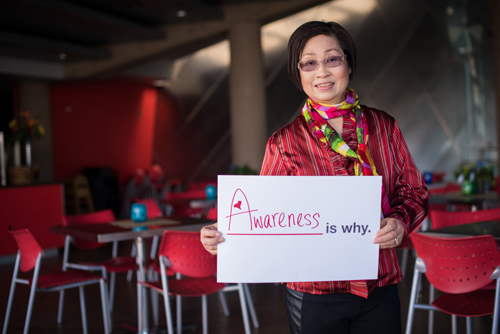By Francesca Minas, American Heart Association
Northwest Asian Weekly

Yee-Mei, Lee Kong, a Go Red For Women Ambassador (Photo by Ike & Tash Photography)
Only a little over half are aware that heart disease is the leading killer of women, responsible for one of every three women’s deaths annually. Believe that heart disease is a “man’s disease” is still a common misperception.
Yee Mei, Lee-Kong of Seattle got a pacemaker in 2010 after experiencing chest pain and shortness of breath. Until she experienced heart trouble and landed in the hospital, she never thought much about her cardiac health. Last February she became a Go Red For Women® ambassador for the American Heart Association, appearing on a billboard for a campaign to inspire women to take charge of their heart health. “She wants to help spread awareness,” says her daughter Nancy Lee, VP, East West Bank and an American Heart Association supporter.
There has been much progress made in raising women’s awareness over the past decade, since the launch of campaigns such as Go Red For Women and the government’s Heart Truth campaign. In 1997, a study from the American Heart Association showed that only 8% of women knew that heart disease was the biggest threat to their health. Today that number is at 54 percent. In addition to awareness, the American Heart Association also set out to build greater awareness about prevention, the signs and symptoms of heart disease in women, as well as doctor’s understanding about women’s bodies and their hearts.
Here’s the shocking truth: about 80% of cardiac events can be avoided by making lifestyle choices. What does this mean for you? Here’s a heart disease prevention checklist:
Choose a healthy lifestyle, which includes a diet rich that emphasizes fruits, vegetables, whole grains, low-fat dairy, lean meats, fish and limits red meats and sugary foods and drinks (like soda.) Include at least 150 minutes of moderate exercise every week, which can be as simple as walking and muscle strengthening, such as yoga. Say no to tobacco. Women who smoke have a higher risk of developing heart disease compared to men who smoke.
Cook heart-healthy. Choose healthy oils, and know the good fats from the bad. The “good” fats are usually derived from plants and seafood and have been shown to improve cholesterol. These are the fats found in fish like salmon and mackerel, and cooking oils such as peanut and olive oils. Remember to emphasize vegetables, fruits, whole grains, and lean protein in your diet. And remember to balance the amount of calories you eat with the amount you burn.
Understand drug therapy options. Lifestyle changes alone can’t always control heart disease risk. You may be prescribed medication to help control blood pressure or your cholesterol. Take them as prescribed.
Work with your doctor. Discuss your health heart with your doctor, including risk factors that may be unique to you, including your family history. Make sure you know your health numbers, such as cholesterol, blood pressure, blood sugar, and BMI. If your doctor lays out a treatment plan to address any risk factors, such as high blood pressure, follow the plan and take an active role in your health by asking questions.
There are many things that can affect your risk for heart disease that you can’t change, such as age and family history, but even modest changes to your diet and lifestyle can improve your heart health and lower your risk by as much as 80 percent.
One thing that has become clear in the last decade: women are not small men. Their symptoms can differ from those in men, and women are notorious for dismissing their symptoms. When Yee Mei experienced shortness of breath and chest pain, her reaction was to lay in bed and hope that her symptoms would go away. It turned out she had a heart valve problem.
Did you know that sweating, pressure, nausea, and even jaw pain can all signal a heart attack in a woman? If you notice these warning signs, be sure to call 9-1-1 so that care can start even before you get to the hospital.
Uncomfortable pressure, squeezing, fullness or pain in the center of your chest that lasts more than a few minutes, or goes away and comes back.
Pain or discomfort in one or both arms, the back, neck, jaw or stomach.
Shortness of breath, with or without chest discomfort.
Other signs such as breaking out in a cold sweat, nausea or lightheadedness.
As with men, the most common heart attack symptom in women is chest pain or discomfort. But women are more likely to experience shortness of breath, nausea/vomiting and back or jaw pain.
A reminder: trust your instincts. If you aren’t feeling normal and suspect a heart attack, call 9-1-1. “Ninety percent of my women patients who’ve just had a heart attack tell me that they knew it was their heart all along. That they just had a feeling,” said Dr. Susanne Steinbaum, director of The Heart and Vascular Institute at Lenox Hill Hospital in New York City. (end)
To learn more about your risk for heart disease, take the online Go Red Heart Checkup at www.heart.org.



